
Iroquois-class destroyers, also known as Tribal class or DDG 280 class, were a class of four helicopter-carrying, guided missile destroyers of the Royal Canadian Navy. The ships were named to honour the First Nations of Canada.
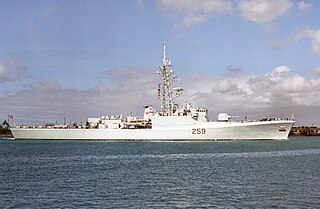
HMCS Terra Nova was a Restigouche-class destroyer that served in the Royal Canadian Navy and later the Canadian Forces from 1959 until 1997. After her final refit, she was a guided missile destroyer.

HMCS Yukon was a Mackenzie-class destroyer that served in the Royal Canadian Navy (RCN) and later the Canadian Forces. She was the first Canadian naval unit to carry the name. She was named for the Yukon River that runs from British Columbia through Yukon and into Alaska in the United States.

HMCS Nipigon was an Annapolis-class destroyer that served in the Royal Canadian Navy and later the Canadian Forces. She was the second Canadian naval unit to carry this name. Entering service in 1964, she was named for the Nipigon River that flows through Ontario.
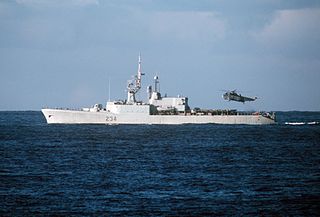
HMCS Assiniboine was a St. Laurent-class destroyer that served in the Royal Canadian Navy and later the Canadian Forces from 1956 to 1988. She was the second ship to bear the name. Entering service in 1956, the ship underwent conversion to a destroyer helicopter escort (DDH) in 1962, the conversion performed primarily by Victoria Machinery Depot. She was officially reclassed with pennant DDH 234 on 28 June 1963. After being paid off in 1988, the vessel was used as a harbour training ship until being discarded in 1995. The vessel sank under tow to the breakers that year.
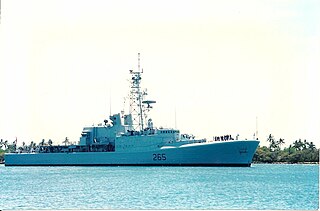
HMCS Annapolis was an Annapolis-class destroyer that served in the Royal Canadian Navy and later, the Canadian Forces. She was the second Canadian naval unit to carry this name. Named for the Annapolis River that flows through Nova Scotia, the ship entered service in 1964, the last of the St. Laurent-class design. Serving through the Cold War, Annapolis was decommissioned in 1998 before going through a protracted legal battle for use as an artificial reef. She was finally scuttled as such in 2015 off the coast of British Columbia.

HMCS Mackenzie was a Mackenzie-class destroyer that served in the Royal Canadian Navy (RCN) and later the Canadian Forces. She was the lead ship of her class and is the first Canadian naval unit to carry this name. The ship was named for the Mackenzie River, the largest river system in Canada and runs primarily through the Northwest Territories.

HMCS Qu'Appelle was a Mackenzie-class destroyer that served in the Royal Canadian Navy and later the Canadian Forces. The ship's insignia and logo was the head of a fox facing forward centered in a diagonal line double white with a red center sqiggley line from the top left to bottom right. The moniker of the ship was "Follow the Fox".
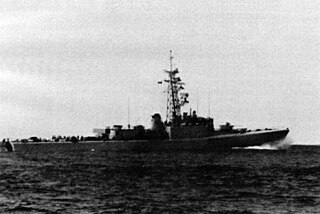
HMCS Restigouche was the lead ship of the Restigouche-class destroyers that served in the Royal Canadian Navy and later the Canadian Forces. Commissioned in 1958, Restigouche remained in service until 1994. She was sold for use as an artificial reef, however controversy arose over her acquisition and instead she was scuttled off the coast of Mexico in 2001. She was the second Canadian warship to carry the name HMCS Restigouche.

HMCS Saguenay was a St. Laurent-class destroyer that served in the Royal Canadian Navy and later the Canadian Forces from 1956–1990. She was the second vessel in her class and the second Canadian naval unit to carry the name HMCS Saguenay. After being discarded by the Canadian Forces, the ship was sunk as an artificial reef off the coast of Nova Scotia.

HMCS Kootenay was a Restigouche-class destroyer escort that served in the Royal Canadian Navy and Canadian Forces from 1959 until 1996. She was the fifth ship in her class and the second vessel to carry the designation HMCS Kootenay. The ship suffered two serious incidents in her career: a 1969 explosion and ensuing fire that killed nine, and a 1989 collision that required the complete replacement of her bow. Following her service, the ship was sunk as an artificial reef.

The Restigouche-class destroyer was a class of seven destroyer escorts that served the Royal Canadian Navy and later the Canadian Forces from the late-1950s to the late-1990s. All seven vessels in the class were named after rivers in Canada.

The Mackenzie-class destroyer was a class of warship used by the Royal Canadian Navy and Canadian Forces from the 1960s–1990s. Six such ships were envisioned, of which four were completed to this specification. The last two hulls were completed to the post DDH conversion St. Laurent-class design ; they were designated as the Annapolis class instead. The four Mackenzie-class destroyers spent most of their service in the Pacific Ocean, used primarily in a training role. Their only significant update was the DELEX program, which was completed between 1982 and 1985 and updated their navigational radar and their sonar.

HMCS Saskatchewan was a Mackenzie-class destroyer that served in the Royal Canadian Navy (RCN) and later the Canadian Forces. She was the second Canadian naval unit to bear the name HMCS Saskatchewan. The ship was named for the Saskatchewan River which runs from Saskatchewan to Manitoba in Canada.

The Annapolis-class destroyer escort was a two-ship class of destroyer escorts that saw service with the Royal Canadian Navy and Canadian Forces from the 1960s to the 1990s. The final version of the St. Laurent-class design, the class was used extensively for anti-submarine warfare purposes. Both ships were sunk as artificial reefs after being retired, one on each coast of Canada.
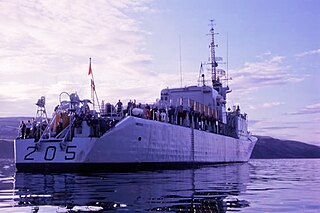
HMCS St. Laurent was a St. Laurent-class destroyer that served in the Royal Canadian Navy and later the Canadian Forces from 1955–1974. She was the lead ship of her class, the first modern warship designed and built in Canada.

HMCS Margaree was a St. Laurent-class destroyer that served in the Royal Canadian Navy and later the Canadian Forces from 1957–1992. She underwent conversion to a destroyer helicopter escort (DDH) in the mid-1960s and was officially reclassed with pennant DDH 230 on 15 October 1965. The vessel served until 1992 when it was discarded, sold for scrap and broken up in 1994.

HMCS Chaudière was a Restigouche-class destroyer and the second vessel of her class that served in the Royal Canadian Navy and later the Canadian Forces from 1959 to 1974. She was the second Canadian naval unit to bear this name. During the summer of 1974 she along with her sister ship HMCS Columbia served as the base of operations for the Esquimalt Sea Cadet Camp while being docked at the DND jetty in Colwood. This location was across the harbour from the main site of CFB Esquimalt. Following the vessel's decommissioning, the ship was used as a source for spare parts for the other surviving members of her class. In 1991, Chaudière was sold for use as an artificial reef and sunk off the coast of British Columbia.

HMCS Gatineau was a Restigouche-class destroyer that served in the Royal Canadian Navy and later the Canadian Forces during the Cold War from 1959 to 1996. She was the third ship in her class and the second vessel to carry the designation HMCS Gatineau. She was sold for scrapping in 2009.

HMCS Columbia was a Restigouche-class destroyer that served in the Royal Canadian Navy and later the Canadian Forces from 1959 to 1974. Columbia was the seventh and final ship in her class and is the second Canadian naval unit to carry the name HMCS Columbia. Following her service, she was kept at Esquimalt in an altered condition, no longer capable of sailing. During the summer of 1974 she along with her sister ship HMCS Chaudiere served as the base of operations for the Esquimalt Sea Cadet Camp while being docked at the DND jetty in Colwood. This location was across the harbour from the main site of CFB Esquimalt. Columbia was sold for use as an artificial reef and sunk off the coast of British Columbia in 1996.


















